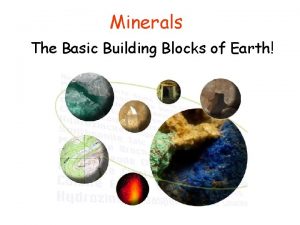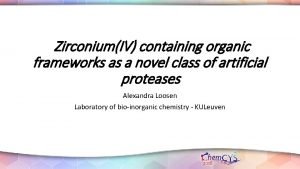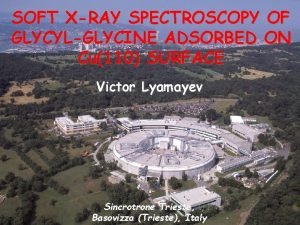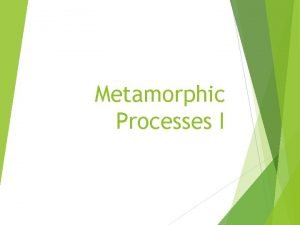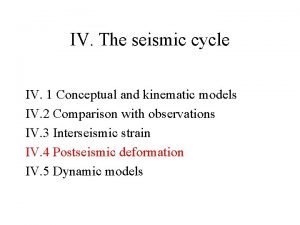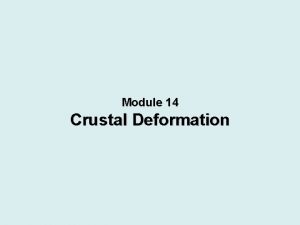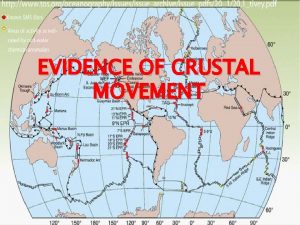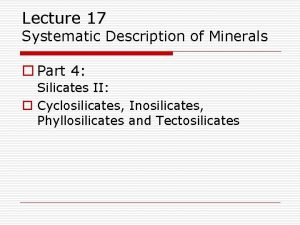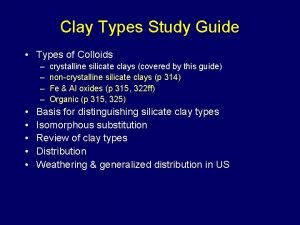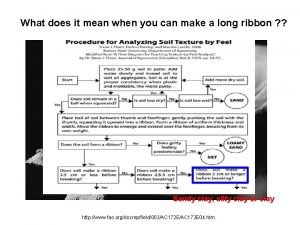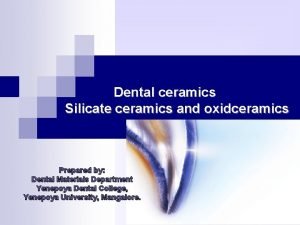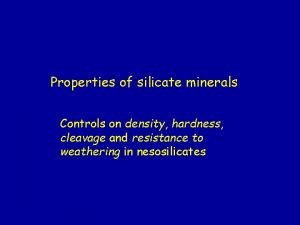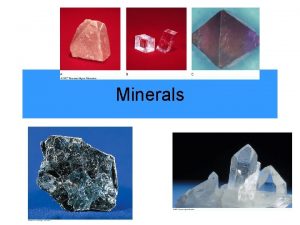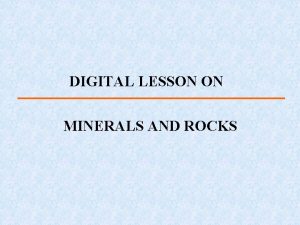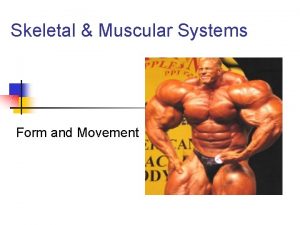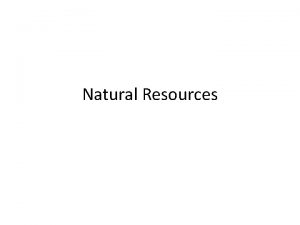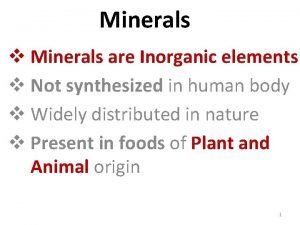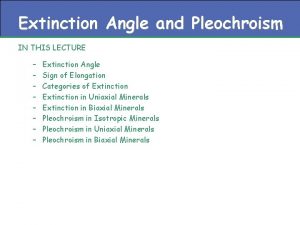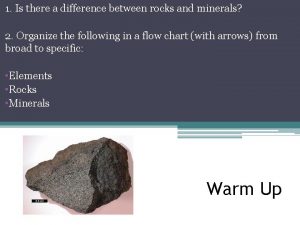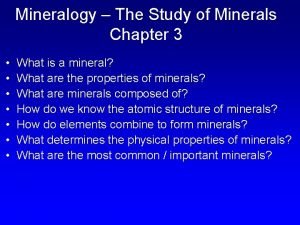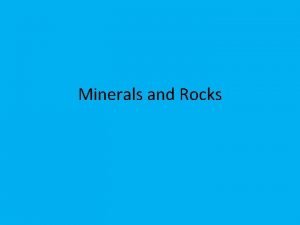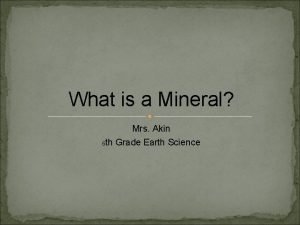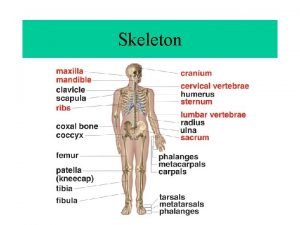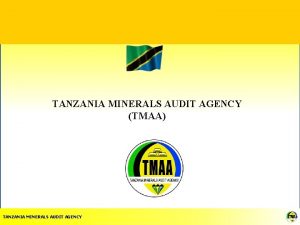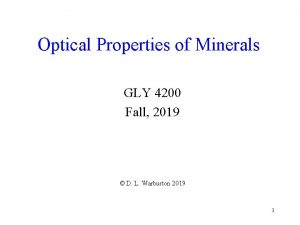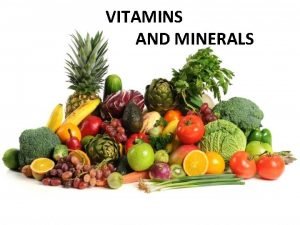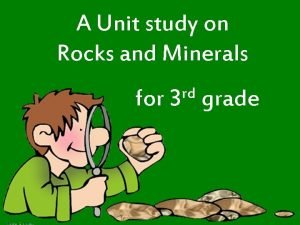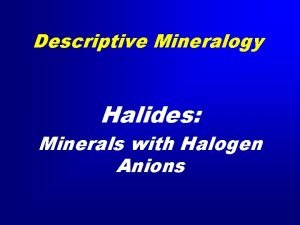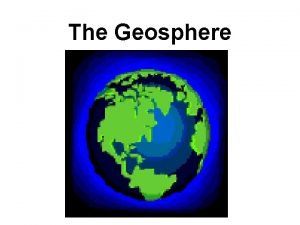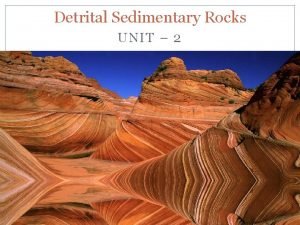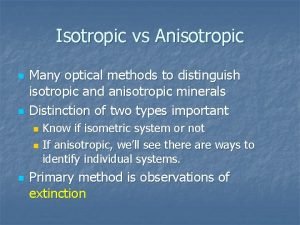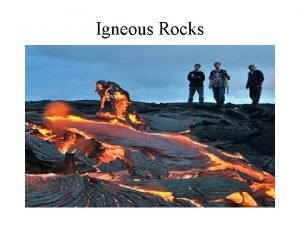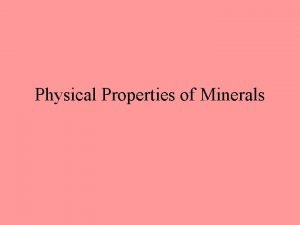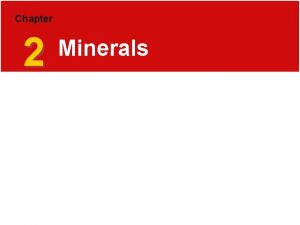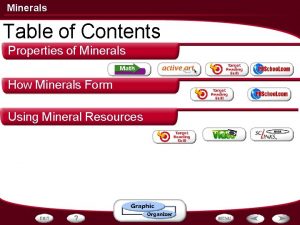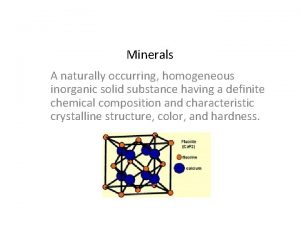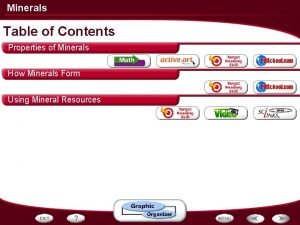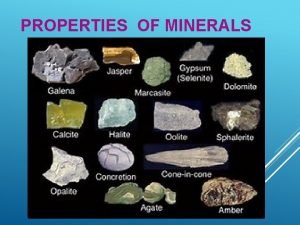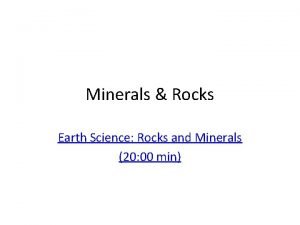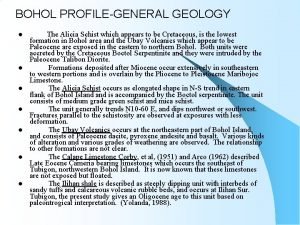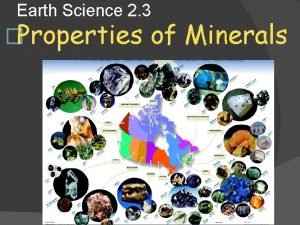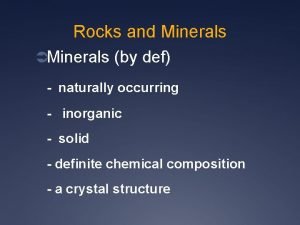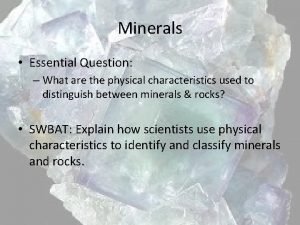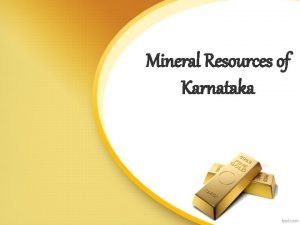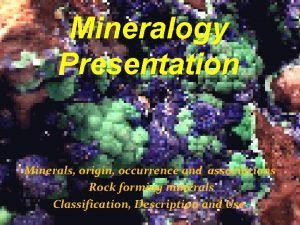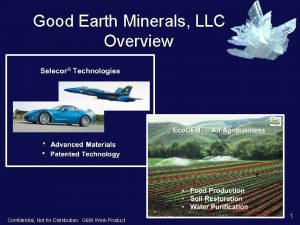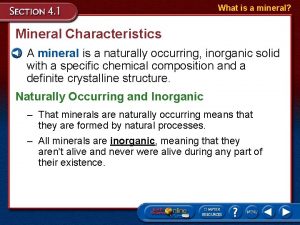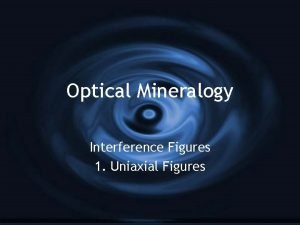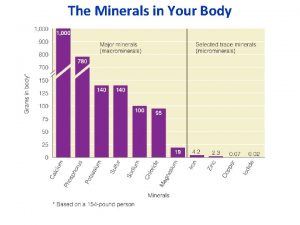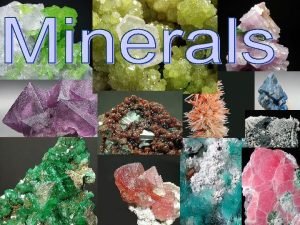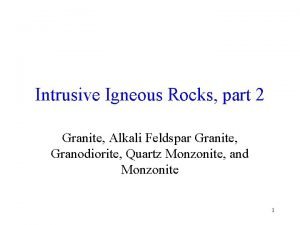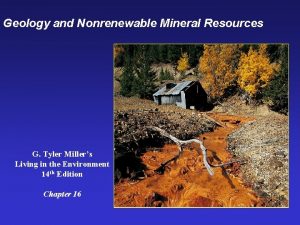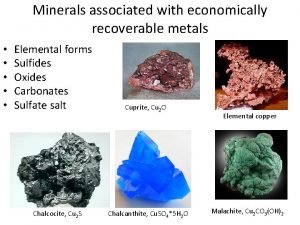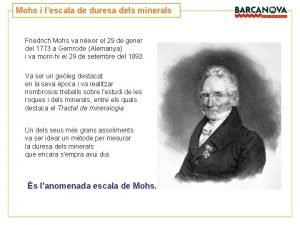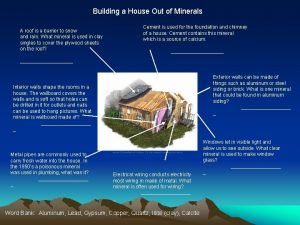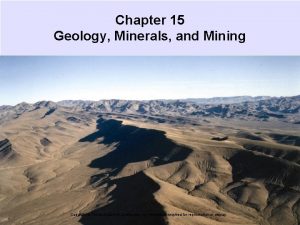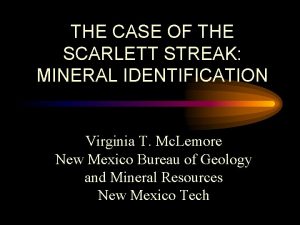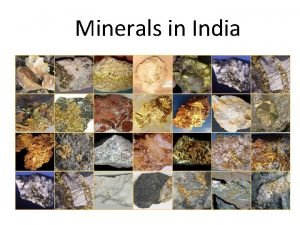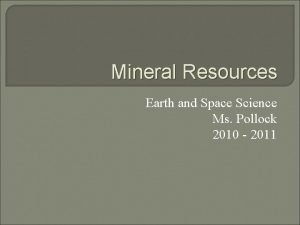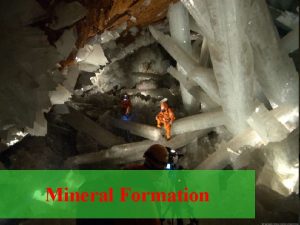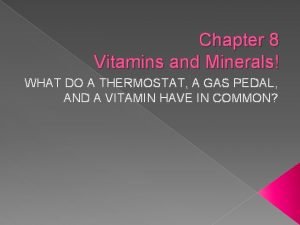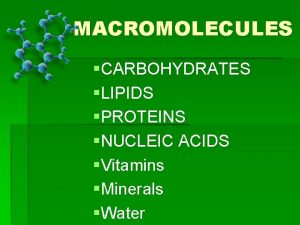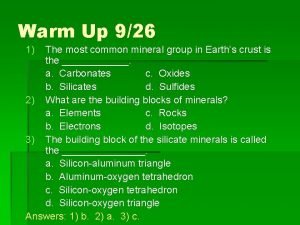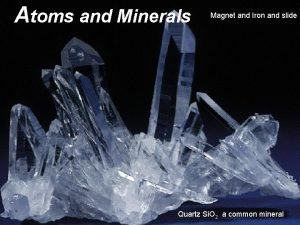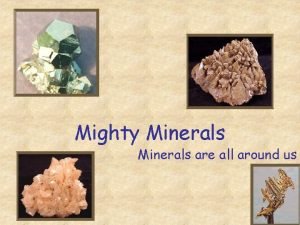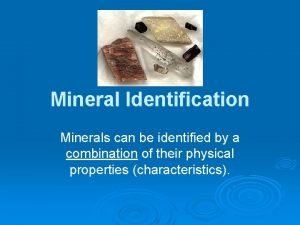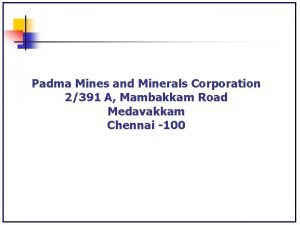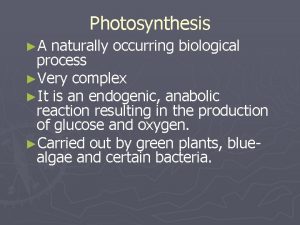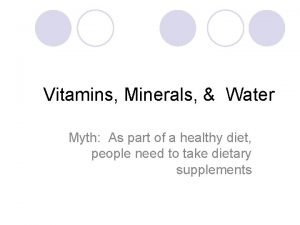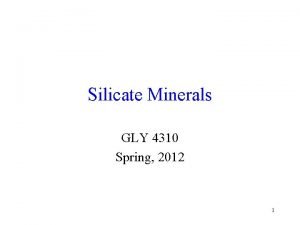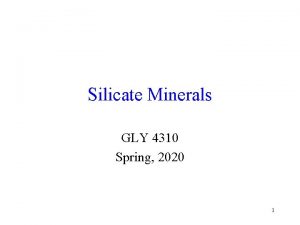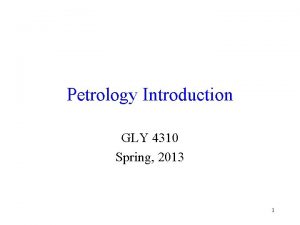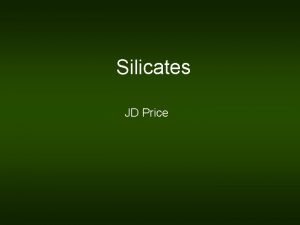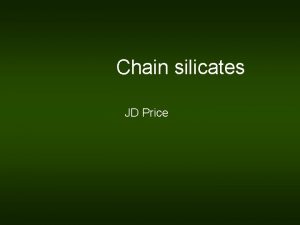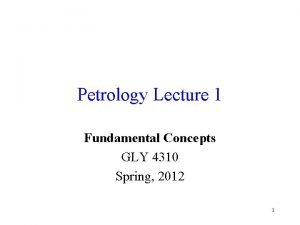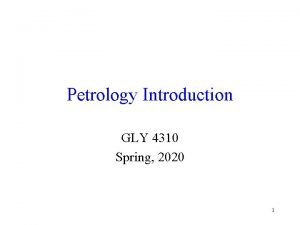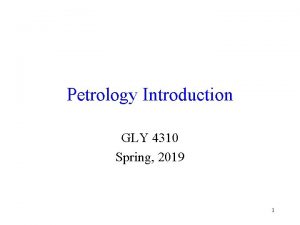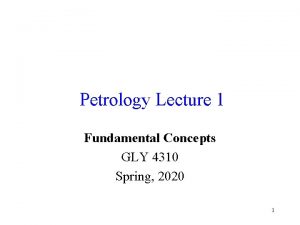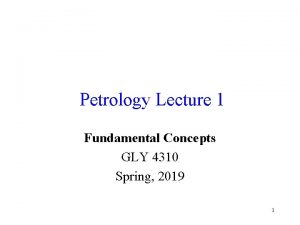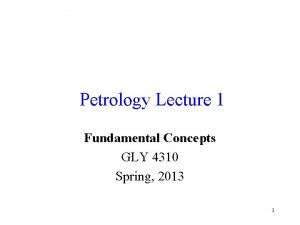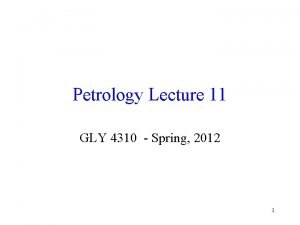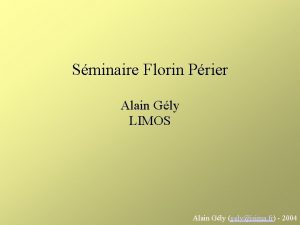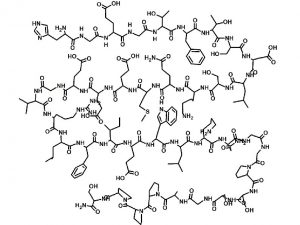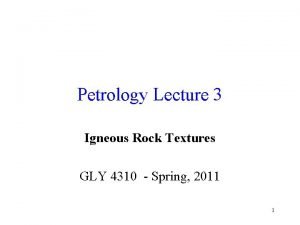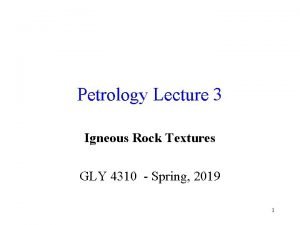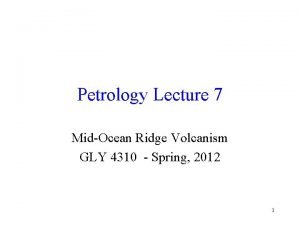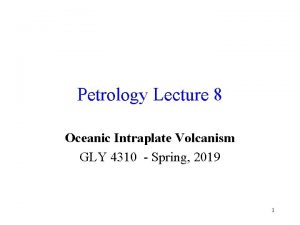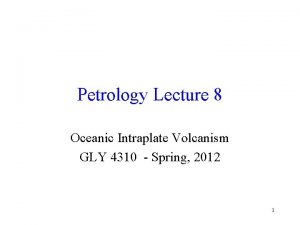Silicate Minerals GLY 4310 Spring 2013 1 Crustal





























































![Amphibole Double Chain Tremolite • Ca 2 Mg 5 [Si 8 O 22] (OH)2 Amphibole Double Chain Tremolite • Ca 2 Mg 5 [Si 8 O 22] (OH)2](https://slidetodoc.com/presentation_image/958fcf859009436a03a796bf4eee2609/image-62.jpg)




































- Slides: 98

Silicate Minerals GLY 4310 Spring, 2013 1

Crustal Chemistry • The earth’s crust is composed of three common elements, on an atom percent basis § Oxygen, 62. 5% § Silicon, 21. 2% § Aluminum, 6. 47% • Silicates are the most common minerals on the planet • They are called “rock-forming” minerals for this reason 2

Other Common Cations • Metal cations also contribute to minerals • On an atom % basis: § § § Sodium, 2. 64 Calcium, 1. 94 Iron, 1. 92 Magnesium, 1. 84 Potassium, 1. 42 3

Types of Silicate Minerals in the Earth’s Crust • Silicates make up 92% of the crust § § § § Plagioclase, 39% Alkali feldspar, 12% Quartz, 12% Pyroxene, 11% Amphiboles, 5% Micas, 5% Clays, 5% Other silicates, 3% 4

Whole Earth • When the mantle and core are included, the compositional picture changes • Olivine is the main constituent of the upper mantle, and may be the most common mineral on earth • The lower mantle is composed of other silicates • The core is believed to be an Fe-Ni mix 5

Mineral Nomenclature • Minerals are classified into classes, such as oxides, carbonates, and silicates • The silicates are divided into subclasses • Within a class or subclass, we may have divisions into groups, such as the garnet group of the subclass nesosilicate or the spinel group of the oxides • Minerals may also be classified as series, such as the olivine series of the nesosilicates 6

Mineral Nomenclature 2 • Individual minerals are known as species, such as forsterite or fayalite of the olivine series • A species may have varieties, such as Iceland Spar, tufa, or travertine of the mineral calcite 7

Silicate Nomenclature Silicate Subclass Alternative Name Neso – (or Ortho) Silicates Sorosilicates Island Cyclosilicates Ring Inosilicates Chain Phyllosilicates Layer Couplet Tectosilicates (or Tekto-) Framework 8

Silicate Anionic Group • The silica tetrahedron is the basis for all the silicate structures • The Si. O 4 tetrahedron has a charge of ? 9

Silicon Tetrahedron 10

Sharing of Oxygen Anions 11

Nesosilicates • Characterized by independent Si 04 tetrahedra, which are not linked together directly • They are bonded together by ionic bonds to interstitial cations • The structures of the nesosilicates are therefore, very dependent on the size and charge of the interstitial cations • Because the tetrahedral do not share oxygen, the Si: 0 ratio is 1: 4. 12

Interstitial Cations • Since the Si. O 4 tetrahedron has a charge of 4, two divalent cations, a trivalent and a monovalent, or a quadravalent cation are required to maintain electrical neutrality • Several structure types are possible – in the silicate structures the letter A = non-silicon cations with lower valency then Si 4+ , B = Si or Al or other higher valent cations, O = oxygen 13

A 2 Si. O 4 • This group includes the olivine series • Structure is based on an nearly HCP arrangement of the O 2 - ions • A ions are in octahedral voids • B ion in a tetrahedral void • ½ of the octahedral voids are occupied, 1/8 of the tetrahedral voids are occupied 14

Olivine Series • Olivine itself is the compound (Fe, Mg)2 Si 04 with a complete solid solution series § As with other solid solution series the two end members are the most important § Fayalite – Fe 2 Si 04 Fa § Forsterite – Mg 2 Si 04 Fo 15

Olivine Solid Solution Ranges • • • Forsterite Chrysolite Hyalosiderite Mortonolite Ferrohortonolite Fayalite 0 -10% Fe 10 -30% Fe 30 -50% Fe 50 -70% Fe 70 -90% Fe 90 -100% Fe 16

Solid Solution Nomenclature • As with some other important series an abbreviation is used for the end members – compositions can be expressed using abbreviated symbols • Example Fe 0. 6 Mg 1. 4 Si 04 = Fa 30 Fo 70 17

Other Olivine Group Minerals • • Ca. Mg. Si 04 Mn 2 Si 04 Ca. Mn. Si 04 Ca. Fe. Si 04 Monticellite Tephroite Glaucochroite Kirschsteinite 18

ASi. O 4 • The most common mineral of this group is the mineral zircon, Zr. Si 04 • In zircon, the A ions are in distorted cubic coordination with 4 oxygens at one distance, 4 further away • Zircon always contains some Hf and sometimes Th or U (may be metamict) • Thorite, Th. Si 04, is isostructural but is often metamict because of radioactive decay 19

Garnets, A 3 B 2(Si. O 4)3 • Larger A site is occupied by divalent cations which are relatively large, with a coordination number of VIII § Typical cations are Ca 2+, Mg 2+, Fe 2+, Mn 2+, and some trivalent lanthanides • The smaller B site is occupied by trivalent cations which are smaller, with a CN of VI § Typical cations A 13+, Cr 3+, Fe 3+, and Ti 4+ 20

Garnet Structure • Silica tetrahedra are linked by the VI coordinated cations to form a three dimensional array • VIII coordinated ions are distributed within this structure • All garnets have isometric hexoctahedral symmetry 21

Calcium and Noncalcium Garnets • Ca 2+ is larger than Mg 2+, Fe 2+ and Mn 2+ • Garnets can be split into two groups, the Ca and non-Ca garnets • A similar division may be made for the B ions into A 1, Fe 3+ and Cr 3+ garnets. 22

Ca Garnets Name Formula Color Uvarovite Ca 3 Cr 2(Si 04)3 Emerald green Grossularite, also Ca 3 A 12(Si 04)3 called cinnamon stone, essonite Andradite Ca 3 Fe 2(Si 04)3 White green, yellow, cinnamon brown, pale red Yellow, green, brown, black 23

Non-Ca Garnets Name Formula Color Pyrope Mg 3 A 12(Si 04)3 Deep red to black Almandine Fe 3 A 12(Si 04)3 Deep red to brown Spessartite Mn 3 A 12(Si 04)3 Brownish to red 24

Garnet Photos Uvarovite Garnet (above) Grossular garnet (above) Grossular, variety hessonite (left) 25

Garnet Photos Andradite garnet (above) Almandine garnet (left and right) 26

Aluminosilicates • Aluminosilicates have aluminum in addition to silicon in the structure • They may belong to any silicate subclass 27

Al 2 Si. O 5 Polymorphs • Kyanite, andalusite, and sillimaite have the same chemistry, but form under different P and T conditions 28

Al 2 Si. O 5 Structures 29

Topaz • • A 12 (Si 04)(F, OH)2 H=8 {001} perfect Used as a gem stone 30

Staurolite • Fe 2 A 1906(Si 04)4(O, OH)2 • Crystals are prismatic • Often twinned (penetration twins), with two varieties of cruciform twins 31

Titanite • Ca. Ti. O(Si 04) • Formerly known as sphene • An example of a titanosilicate • N = 1. 91 – luster resinous to adamantine 32

Willimite Willemite with Franklinite and Quartz New Jersey • Zn 2 Si. O 4 • Associated with other Zn ores • Mn may replace Zn • Often fluorescence 33

Sorosilicates • Characterized by two Si 04 tetrahedra joined through a single oxygen to give an Si: O ratio of 2: 7 34

Epidote Group • Contains both Si 04 and Si 207 groups • General formula is X 2 VIIIY 3 VI(Si 04)O(OH) • X = Ca 2+, Na+ • Y = A 13+, Fe 3+, Mn 3+, Cr 3+ • Epidote: Ca 2(A 1, Fe)A 12 O(Si 2 O 7)(Si. O 4)(OH) • Clinozoisite: Ca 2 A 13 O (Si 2 O 7)(Si. O 4)(OH) 35

Vesuvianite • Formerly called Idocrase • Ca 10(Mg, Fe)2 A 14(Si 04)5(Si 207)2( OH)7 • Tetragonal H = 6 ½ • Brown or green 36

Hemimorphite • Zn 4(Si 207)(OH)2 H 20 is one mineral of the sorosilicate group with isolated Si 207 groups, cross linked by Zn cations • Formed as a secondary mineral in the oxidized portions of zinc deposits 37

Lawsonite • Ca. A 12(OH)2 Si 2 O 7 H 2 O • Found only in metamorphic blue (glaucophane)-schist or similar low temperature, moderate to high pressure environments. 38

Cyclosilicates • When three or more Si tetrahedral groups are linked, a cyclical structure is possible • The Si: O ratio is 1: 3 • Rings containing 3, 4, or 6 Si are possible, but only the rings with 6 Si are at all common 39

Cyclic Silicates 3 membered ring 6 membered rings 40

Beryl Structure A single unit cell of beryl • • Yellow Si tetrahedra are in the upper layer, the green ones in the lower layer The outer points of the tetrahedra are actually edges viewed along their length Purple tetrahedra contain Be and are viewed down their four-fold inversion axes They connect the bottom corners of the tetrahedra in the upper ring with the top corners of the tetrahedra in the lower ring • Solitary blue atoms are Al, in VI-fold coordination with the adjacent tetrahedral oxygens 41

Complete Beryl Lattice • Shows the octahedral coordination of Al in blue 42

Gem Beryl • Upper left, emerald • Lower left, morganite • Upper right, aquamarine • Lower right, golden beryl 43

Tourmaline • Elbaite, a gem variety of tourmaline • Schorl crystal, with Striations, typical of tourmaline 44

Chrysocolla • Amorphous but similar to dioptase, a sixmembered cyclosilicate • May contain Si 4 O 10 units, which would make it a phyllosilicate 45

Inosilicates • Inosilicates include two very important groups of silicates, the pyroxenes and the amphiboles • Both have chain structures • Si 04 tetrahedra link together to form either a single chain or a double chain composed of two linked, parallel single chains 46

Pyroxene Chain • Single chain of Si. O 4 tetrahedra connected by sharing a corner 47

Orthopyroxenes • Enstatite • Hypersthene • Orthoferrosilite Mg. Si. O 3 (Mg, Fe)Si. O 3 Fe Si. O 3 48

Enstatite • Brownish orthopyroxene (opx) • Lower photo is of Bronzite, an opx containing some Fe, and displaying an iridescence known as Schiller luster 49

Clinopyroxenes • • X Y Diopside Ca Mg Hedenbergite Ca Fe 2+ Augite Ca (Mg, Fe 2+) (Al, Fe 3+, Ti) Pigeonite (Mg, Fe 2+, Ca) (Mg, Fe 2+) (Al, Fe 3+)Si 2 O 6 Aegirine Na Fe 3+ Jadeite Na Al Spodumene Li Al Si 2 O 6 Si 2 O 6 50

Pyroxene “Quad” • The pyroxene quadrilateral forms part of a larger ternary system (Ca. Si. O 3 -Mg. Si. O 3 Fe. Si. O 3), that includes another single chain silicate wollastonite • The Ca-rich clinopyroxenes are separated from the orthopyroxenes, and from the Ca-poor clionpyroxene pigeonite by a solvus (shown in green in the figure) 51

Augite • Augite is distinguished by 2 D cleavage @ 90° • Al occurs at tetrahedral sites, so trivalent cations are present at normally divalent sites 52

Pyroxene Structure • X: VIII coordination Na+ or Ca 2+ • Y: VI coordination Mg, Fe 2+, Fe 3+, Al 3+, Mn 2+, Mn 3+, Li+, Ti 4+ • Si: IV coordination Si 4+ or Al 3+ 53

Diopside Structure • • Diopside (001) view Blue = Si Purple = M 1 (Mg) Yellow = M 2 (Ca) 54

Spodumene Series • The spodumene series of pyrxoenes involves X sites occupied by moderate to large size cations, Y by small trivalent cation • Spodumene Li Al Si 2 O 6 • Jadeite Na Al Si 2 O 6 • Aegerine Na Fe 3+ Si 2 O 6 55

Pyroxenoid Structure • Large cations occupy both X and Y, producing the triclinic structure of the pyroxenoids • Chains made of Si 2 O 7 and Si. O 4 groups linked together are present, and the chains are parallel to b • Si: O = 1: 3 56

Pyroxene vs. Pyroxenoid 7. 1 A 12. 5 A 5. 2 A Pyroxene 2 -tet repeat Wollastonite Rhodonite (Ca M 1) Mn. Si. O 3 3 -tet repeat 5 -tet repeat • “Ideal” pyroxene chains with 5. 2 Å repeat (2 tetrahedra) become distorted as other cations occupy VI sites • Note presence of Si 2 O 7 couplets 57

Pyroxenoids • Top, pectolite • Middle, wollastonite • Bottom, rhodonite 58

Amphibole Chain • Double chain of Si. O 4 tetrahedra connected by corner sharing 59

Amphibole Structure • Amphiboles have a double chain structure formed by sharing three corners • All have the basic Si 4 O 11 double chains, with larger X ions are in VIII coordination, while smaller Y cations are in VI coordination • Si: O = 1: 2. 75 60

Amphibole Formula • • • The general formula is: W 0 -1 X 0 -7 Y 7 -14 Z 16 O 44(OH)4 X: Na+, Ca 2+, minor K+, Mn 2+, Fe 2+, Mg 2+, Li+ Y: Mg 2+, Fe 3+, Al 3+, Mn 2+, Mn 3+, Ti 4+ Z: Si 4+, Al 3+ 61
![Amphibole Double Chain Tremolite Ca 2 Mg 5 Si 8 O 22 OH2 Amphibole Double Chain Tremolite • Ca 2 Mg 5 [Si 8 O 22] (OH)2](https://slidetodoc.com/presentation_image/958fcf859009436a03a796bf4eee2609/image-62.jpg)
Amphibole Double Chain Tremolite • Ca 2 Mg 5 [Si 8 O 22] (OH)2 • (001) view • Blue = Si • Purple = M 1 • Rose = M 2 • Gray = M 3 (all Mg) • Yellow = M 4 (Ca) 62

Amphibole Double Chain – Hornblende • (Ca, Na)2 -3 (Mg, Fe, Al)5 [(Si, Al)8 O 22] (OH)2 • (001) view • Dark blue = Si, Al • Purple = M 1 • Rose = M 2 • Light blue = M 3 (all Mg, Fe) • Yellow ball = M 4 (Ca) • Purple ball = A (Na) • Little turquoise ball = H 63

Amphibole Site Size Hornblende (001) view Dark blue = Si, Al, Purple = M 1, Rose = M 2, Light blue = M 3 (all Mg, Fe) Yellow ball = M 4 (Ca) Purple ball = A (Na) Little turquoise ball = H • M 1 -M 3 are small sites • M 4 is larger (Ca) • A-site is really big • Variety of sites great chemical range 64

Pyroxene Cleavage • Aegirine – a sodic pyroxene 65

Amphibole Cleavage • Hornblende 66

Orthoamphibole X, Y Z Anthopyllite (Si 8 O 22) (Mg, Fe 2+)7 (OH, F)2 67

Clinoamphiboles 68

Phyllosilicates • Phyllon is the Greek word for leaf – phyllosilicates are thus "leaf-like", platy or flaky minerals which have a layered structure • The basic silicate sheet structure is composed of a hexagonal grouping of tetrahedra 69

Micas • Micas are the chief minerals of schist's and are also commonly found in igneous rocks • They form at lower temperatures than the inosilicates (pyroxenes and amphiboles) and are frequently formed as replacement minerals after hydrothermal alteration • Ratio of Si: O is 2: 5 70

Siloxane Sheet • Sheet stretches indefinitely in two dimensions 71

Hydrogen Bonding • Hydrogen bonds help to hold siloxane sheets together 72

Brucite Structure • All cation positions filled by divalent ions 73

Gibbsite Structure • Two-thirds of the cation positions filled by divalent ions 74

Diphormic Phyllosilicates • • One t-layer, one o-layer 0. 7 nm repeat distance Kaolinite - dioctahedral A 14[Si 4 O 10](OH)8 Serpentine – trioctahedral Mg 6[Si 4 O 10](OH)8 75

Chrysotile • Fibrous diphormic phyllosilicate 76

Triphormic Phyllosilicates • In this phyllosilicate the ratio of tetrahedral : octahedral layers is 2: 1 • Basal spacing is generally around 0. 9 nm • The structure is a t-o-t sandwoch, with apical oxygens pointing inward • Pyrophyllite – dioctahedral Al 2{Si 4 O 10}(OH)2 • Talc - trioctahedral Mg 3{Si 4 O 10}(OH)2 77

Micas • Another example of triphormic phyllosilicates • The t-o-t layers are held together by layers of K+ cations, in the holes of the rings • To balance the plus charge of the K ion, one quarter of the Si 4+ are replaced by Al 3+ 78

Brittle Micas • Half of the Si 4+ ions are replaced by A 13+ • This means the interlayer cations be divalent, like Ca 2+ • Ca 2+ bonds are stronger and consequently the cages are not flexible • Margite - dioctahedral Ca. Al 2{Al 2 Si 2 O 10}(OH)2 • Clintonite - trioctahedral Ca. Mg 3{Al 2 Si 2 O 10}(OH)2 79

Swelling Clays • Building damaged by expansion and contraction of clay minerals in the soil 80

Tetraphormic Phyllosilicates • t-o-t layers of either the pyrophyllite or talc type are joined by octahedral layers • tot o tot Repeat distance is 1. 4 nm • These minerals are chlorites § Leptochlorites § Orthochlorites Fe 2+ + Fe 3+ Fe 2+ only • [(Fe, Mg, Al)2 -3(OH)6(Mg, Fe, Al)2 -3{Al, Si)4 O 10}(OH)2] 81

Tectosilicates • The tectosilicates are three – dimensional, or framework, silicates • They involve linkage of Si. O 4 tetrahedra through all four oxygen atoms • The resulting structure is stable and strongly bonded • Si: O ratio is 1: 2 82

Varieties of Crystalline Quartz Amethyst Blue Milky Citrine Rose 83

Varieties of Cryptocrystalline Quartz Jasper Chert Chalcedony Chrysoprase 84

Feldspars • Alkali – Potassium and Ab 95 -100 • Plagioclase An 5 -100 • Barium § Celsian Ba. Al 2 Si 2 O 8 § Hyalophane (K, Ba)(A 1, Si)2 Si 2 O 8 85

Feldspar Composition 86

Alkali Feldspars • K-spar shows a variety of polymorphic forms § Sanidine § Orthoclase § Microcline Orthoclase Sanidine 87

Perthite and Antiperthite • Albite in K-spar host = perthite • K-spar in plagioclase host = antiperthite Perthite 88

Plagioclase Name • Plagioclases are triclinic • Their a-b and b-c angles are a bit more oblique than microcline • Hence the name: plagio-, oblique and clase, break Albite 89

Plagioclase Feldspars • Albite § An 0 -10 - Found only in very sodic rocks, hence usually metamorphic or formed in marine conditions as a sedimentary cement, or by ion exchange with more calcic plagioclase. • Oligoclase § An 10 -30 - The dominant plagioclase in granitic rocks • Andesine § An 30 -50 - Found in intermediate igneous rocks • Labradorite § An 50 -70 - The dominant plagioclase in gabbro and basalt. Also, despite their name, most anorthosites are made up of labradorite. • Bytownite § An 70 -90 - The rarest. Requires both a lot of calcium and also significant sodium. Most igneous settings have too much sodium, most calc-silicate metamorphic settings have too little sodium. • Anorthite § An 90 -100 - Generally a metamorphic mineral in calc-silicate rocks. 90

Charge Balance • Since Na and Ca differ in valence, Al has to substitute for Si to compensate • The Al-Si orderings of albite and anorthite are different, and at low temperatures, plagioclases in the middle of the composition range also exsolve, but on a submicroscopic scale • These submicroscopic textures are probably responsible for the iridescence of some plagioclases 91

Feldspathoids • Alumino – silicates but contain less Si. O 2 than feldspars • They are rich in alkalis • The feldspathorids often include unusual anions such as Cl-, CO 3 -, etc. 92

Important Feldspathoids 93

Scapolites • Metamorphic rock minerals probably derived from feldspars • The alumino-silicate framework forms chains in the c-direction and has large open spaces which can accommodate large anions such a Cl, CO 3, SO 4 94

Scapolite Minerals • Marialite Na 4(Al. Si 3 O 8)3(Cl 2, CO 3, SO 4) • Meionite Ca 4(Al 2 Si 2 O 8)3(Cl 2, CO 3, SO 4) Marialite cluster 95

Zeolites Stilbite • Hydrous alumino-silicates with very open structures. • Rings of A 1 O 4 and Si. O 4 tetrahedra are penetrated by open channels in the structure • Non-silicon cations hold the structure together. 96

Cation Exchange • Water can easily pass though these channels and dissolve and replace the cations present in the structure • This process in known as cation exchange and is reversible • Thus, the zeolites can serve as catalysts and watersoftening agents • Petroleum companies have been particularly interested in zeolites for this reason 97

Important Natural Zeolites • Chabazite Ca 2(Al 2 Si 4 O 12)∙ 6 H 2 O • Heulandite Ca(Al 2 Si 7018)∙ 6 H 2 O • Stilbite (Na, K, Ca 0. 5)9 Na(Al 9 Si 27 O 72)∙ 28 H 2 O • Natrolite Na 2(Al 2 Si 3 O 10)∙ 2 H 2 O • Analcime Na(Al. Si 2 O 6)∙H 2 O 98
 Luster
Luster The basic building block of the silicate minerals
The basic building block of the silicate minerals Graphite hardness mohs scale
Graphite hardness mohs scale Rg 4310/2018
Rg 4310/2018 Coordination isomerism
Coordination isomerism Gly
Gly Gly
Gly Crustal deformation
Crustal deformation Crustal extension
Crustal extension Crustal deformation
Crustal deformation Earths major crustal plates
Earths major crustal plates Crustal deformation
Crustal deformation Crustal movement examples
Crustal movement examples Opx
Opx Crystalline silicate clays
Crystalline silicate clays Zinc ethyl silicate primer
Zinc ethyl silicate primer Is muscovite a silicate
Is muscovite a silicate Dental silicate ceramic
Dental silicate ceramic Silicate hardness
Silicate hardness Four seasons korean movie
Four seasons korean movie Spring summer autumn winter dates
Spring summer autumn winter dates Cgc minerals
Cgc minerals Why do humans cannot survive without minerals?
Why do humans cannot survive without minerals? Importance of minerals
Importance of minerals Concept map for rocks
Concept map for rocks Stores minerals and anchors muscles
Stores minerals and anchors muscles Materials or substances such as minerals forests
Materials or substances such as minerals forests Minerals are inorganic elements that the body
Minerals are inorganic elements that the body Elements are moved between minerals during metamorphism by:
Elements are moved between minerals during metamorphism by: Minerals foods
Minerals foods How to measure extinction angle
How to measure extinction angle Difference between rock and stone
Difference between rock and stone Mohs scale of hardness
Mohs scale of hardness Characteristic of minerals
Characteristic of minerals What minerals do plants need
What minerals do plants need Akin minerals
Akin minerals Storage of minerals
Storage of minerals Tanzania minerals audit agency
Tanzania minerals audit agency Function of niacin
Function of niacin Optical properties of minerals
Optical properties of minerals Define macro minerals
Define macro minerals Difference between minerals and rocks
Difference between minerals and rocks Halides minerals
Halides minerals Minerals in the soil
Minerals in the soil What are detrital sedimentary rocks
What are detrital sedimentary rocks Isotropic vs anisotropic minerals
Isotropic vs anisotropic minerals Pumice rock type
Pumice rock type Rocks and minerals song
Rocks and minerals song Vitamins sources functions and deficiency chart
Vitamins sources functions and deficiency chart Properties of minerals
Properties of minerals Chapter 2 minerals
Chapter 2 minerals Cumbria minerals and waste local plan
Cumbria minerals and waste local plan The uses of minerals
The uses of minerals Homogeneous minerals
Homogeneous minerals Physical properties of minerals graphic organizer answer
Physical properties of minerals graphic organizer answer Properties of minerals
Properties of minerals Minerals
Minerals Minerals characteristics
Minerals characteristics Minerals in bohol
Minerals in bohol Define streak in earth science
Define streak in earth science Minerals def
Minerals def Characteristics of minerals
Characteristics of minerals Minerals found in karnataka
Minerals found in karnataka Prepare chart for vitamins and minerals
Prepare chart for vitamins and minerals Minerals and fuels
Minerals and fuels Good earth minerals
Good earth minerals Uses of minerals
Uses of minerals Semi circular bunds
Semi circular bunds Food pyramid carbohydrates fats proteins
Food pyramid carbohydrates fats proteins Interference figure uniaxial minerals
Interference figure uniaxial minerals Enzim
Enzim Nintendo conflict minerals
Nintendo conflict minerals Calcite vs gypsum
Calcite vs gypsum Hp conflict minerals
Hp conflict minerals Minerals in granite
Minerals in granite Economic minerals
Economic minerals Rock type
Rock type Difference between minerals and rocks
Difference between minerals and rocks Minerals
Minerals Duresa dels minerals
Duresa dels minerals 10 most abundant elements in the earth's crust
10 most abundant elements in the earth's crust Conclusion of minerals
Conclusion of minerals Streak of minerals
Streak of minerals Metallic minerals
Metallic minerals Ore minerals
Ore minerals Things made up of stone
Things made up of stone Suzanna socked me sunday poem
Suzanna socked me sunday poem Chapter 8 vitamins and minerals
Chapter 8 vitamins and minerals Are vitamins and minerals macromolecules
Are vitamins and minerals macromolecules Most abundant minerals in earth's crust
Most abundant minerals in earth's crust Mineral non examples
Mineral non examples Snife minerals
Snife minerals This determines the heaviness of a mineral
This determines the heaviness of a mineral Padma mines and minerals corporation
Padma mines and minerals corporation Chapter 4 lesson 4 metamorphic rocks answer key
Chapter 4 lesson 4 metamorphic rocks answer key Minerals and fuels
Minerals and fuels Fair trade minerals
Fair trade minerals Function of minerals
Function of minerals Minerals vs rocks
Minerals vs rocks
